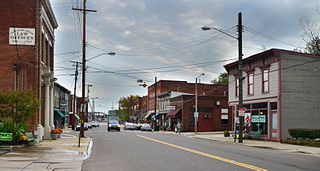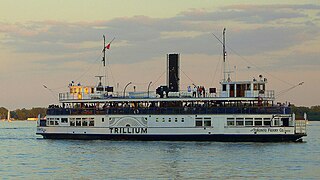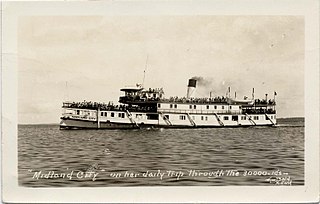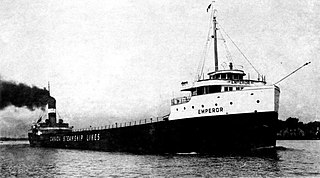
Ashtabula is the most populous city in Ashtabula County, Ohio, United States. It lies at the mouth of the Ashtabula River, on Lake Erie, 53 miles (85 km) northeast of Cleveland. At the 2020 census, the city had 17,975 people. Like many other cities in the Rust Belt, it has lost population because of a decline in industrial jobs since the 1960s. It is part of the Cleveland metropolitan area.

A railroad car float or rail barge is a specialised form of lighter with railway tracks mounted on its deck used to move rolling stock across water obstacles, or to locations they could not otherwise go. An unpowered barge, it is towed by a tugboat or pushed by a towboat.
Port Burwell is a community on the north shore of Lake Erie, in the Municipality of Bayham in Elgin County, Ontario, Canada. It is situated at the mouth of Big Otter Creek, which stretches more than forty miles north through Bayham to Tillsonburg and Otterville, and the harbour at Port Burwell was of historic importance in the development of landlocked Oxford County.

Port Burwell Marine Museum and Historic Lighthouse is a historical museum in Port Burwell, Ontario, Canada. Located at the mouth of the Big Otter Creek on Lake Erie, the museum and lighthouse reflect upon when Port Burwell was at the height of its fame as a shipbuilding community.
Ben Moreell (1892–1978) was a 20th-century USN admiral.
Ben Moreell was a lake freighter on the North American Great Lakes.

Trillium is a side wheeler ferry operated by the City of Toronto Parks, Forestry and Recreation, in Toronto, Ontario, Canada. Now 114 years old, she is one of several Toronto Island ferries operating between the Jack Layton Ferry Terminal at Bay Street and Queens Quay and three landing points on the Toronto Islands. She is the last sidewheel-propelled vessel on the Great Lakes.

SS Midland City was originally a Canadian side-wheel steamboat that provided passenger and cargo transportation on the Great Lakes from 1871 until 1955. Originally named Maud, then America, she underwent several extensive refits over her 84-year service, and saw several owners. The ship was intentionally run aground and burnt to the waterline in 1955 near the mouth of the Wye River in Midland Bay. The wreck is intact and visible above the water to this day, where it acts as a breakwater for the Wye Heritage Marina and local attraction.

SS Marquette & Bessemer No. 2 was a train ferry that sank with the loss of between 30 and 38 lives on Lake Erie on December 8, 1909.

The SS John Sherman, originally the USRC Sherman or USRC John Sherman was built for the United States Revenue Cutter Service in 1865 before being disposed of by the United States Government in 1872. It was a United States sidewheeler ship initially used as a Revenue Cutter on the Great Lakes of North America before being used for ferry service across Lake Michigan between the states of Michigan and Wisconsin. In 1874 the ship was chartered by Flint and Pere Marquette Railroad to become the first ship used by the company transporting freight and passengers.

SS Amasa Stone was a 545-foot (166 m) Great Lakes freighter that was sunk as a breakwater in 1965, Charlevoix, Michigan. She was built for the Mesaba Steamship Company by the Detroit Shipbuilding Company of Wyandotte, Michigan. She was launched on March 25, 1905, as hull #158. She was powered by an 1,800-horsepower (1,300 kW) triple expansion steam engine and two scotch marine boilers.

SS Willis L. King was a 600-foot-long (180 m), steel-hulled, propeller-driven American Great Lakes freighter built in 1911 by the Great Lakes Engineering Works of Ecorse, Michigan. She was scrapped in 1984 in Ashtabula, Ohio. Willis L. King is best known for her collision with the steamer Superior City on August 20, 1920, in Whitefish Bay.

SS Choctaw was a steel-hulled American freighter in service between 1892 and 1915, on the Great Lakes of North America. She was a so-called monitor vessel, containing elements of traditional lake freighters and the whaleback ships designed by Alexander McDougall. Choctaw was built in 1892 by the Cleveland Shipbuilding Company in Cleveland, Ohio, and was originally owned by the Lake Superior Iron Company. She was sold to the Cleveland-Cliffs Iron Company in 1894 and spent the rest of her working life with it. On her regular route between Detroit, Escanaba, Marquette, and Cleveland, she carried iron ore downbound, and coal upbound.
The following index is provided as an overview of and topical guide to Wikipedia's articles on recreational dive sites. The level of coverage may vary:

104 was an American whaleback barge in service between 1890 and 1898. The fourth whaleback constructed, she was built between October 1889 and February 1890, in Duluth, Minnesota by Alexander McDougall's American Steel Barge Company, for McDougall's fleet of the same name, based in Buffalo, New York. She was a whaleback, a class of distinctive, experimental ship designed and built by McDougall. The whalebacks were designed to be more stable in high seas. They had rounded decks, and lacked the normal straight sides seen on traditional lake freighters. 104 entered service on April 21, hauling iron ore from Two Harbors, Minnesota.

SS Ironsides was a wooden-hulled American package freighter in service between 1864 and 1873. She was built in 1864 in Cleveland, Ohio, by either Ira Lafrinier or Quayle & Martin. She was built for John E. Turner, also of Cleveland, and operated as part of the Cleveland & Lake Superior Line. She had an identical sister ship named Lac La Belle. Ironsides operated between Cleveland and Lake Superior for a number of years, and was sold several times. In 1869, she was sold to Nathan Englemann of Milwaukee, Wisconsin, and operated between Milwaukee and Grand Haven, Michigan. In 1871, she became part of the Englemann Transportation Company.

SS Lac La Belle was a wooden-hulled American package freighter in service between 1864 and 1872. She was built in 1864 in Cleveland, Ohio, by Ira Lafrinier for Hanna & Garretson, also of Cleveland. She had an identical sister ship named Ironsides. Lac La Belle operated between Cleveland and Lake Superior for a number of years, and was sold several times. In 1869, she was sold to Nathan Englemann of Milwaukee, Wisconsin, and operated between Milwaukee and Grand Haven, Michigan. In 1871, she became part of the Englemann Transportation Company. Throughout her career, Lac La Belle was involved in several accidents.

SS Emperor was a steel-hulled Canadian lake freighter in service between 1911 and 1947. She was built between 1910 and April 1911 by the Collingwood Shipbuilding Company in Collingwood, Ontario, for Inland Lines, Ltd., of Midland, Ontario. She entered service on May 3, 1911. Emperor was sold to Canada Steamship Lines of Montreal, Quebec. Under the ownership of Canada Steamship Lines, she carried a wide variety of cargoes, but most frequently iron ore to Point Edward, Ontario, where it would be transported to Hamilton, Ontario, by train. After the opening of the fourth Welland Canal, Emperor carried the ore directly to Hamilton. She was involved in several accidents throughout her career.














